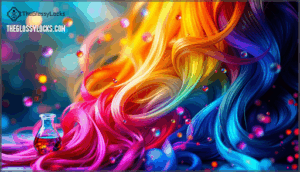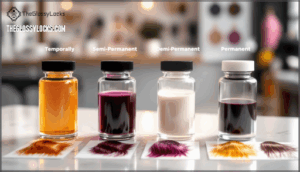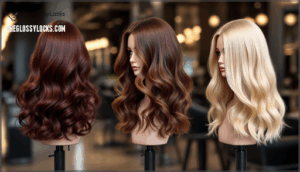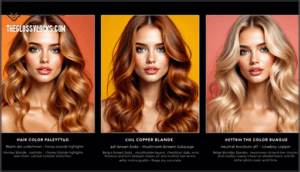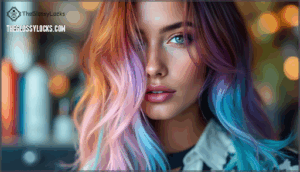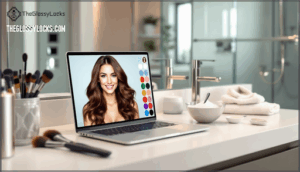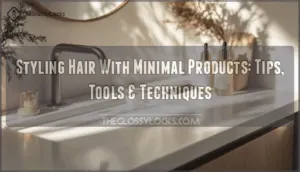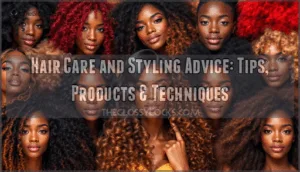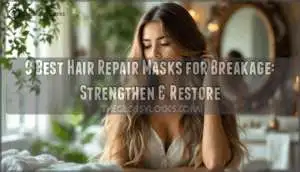This site is supported by our readers. We may earn a commission, at no cost to you, if you purchase through links.
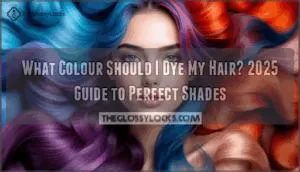 You’ve probably stood in front of the mirror dozens of times, grasping swatches or scrolling through inspiration photos, asking yourself what colour should I dye my hair. Roughly 75% of people choose shades that clash with their undertone, which means they end up disappointed with results that don’t flatter their complexion.
You’ve probably stood in front of the mirror dozens of times, grasping swatches or scrolling through inspiration photos, asking yourself what colour should I dye my hair. Roughly 75% of people choose shades that clash with their undertone, which means they end up disappointed with results that don’t flatter their complexion.
The right hair color isn’t just about trends or personal preference—it’s about understanding how your skin tone, natural base, and hair texture work together. Once you know how to decode these factors, you’ll stop second-guessing and start picking shades that genuinely improve your look.
Table Of Contents
- Key Takeaways
- What Colour Should I Dye My Hair?
- How Colour Theory Influences Hair Dye Choices
- Comparing Hair Dye Types and Commitment Levels
- Trending Hair Colours and Inspiration for 2025
- Tools and Tips for Choosing Your Perfect Colour
- Frequently Asked Questions (FAQs)
- How often should I dye my hair?
- What are the safest hair dyes to use?
- How can I make my hair color last longer?
- Is there a way to test a hair color before committing to it?
- Are there any natural alternatives to dyeing my hair?
- How do I know if my hair can handle permanent color?
- Whats the difference between box dye and salon dye?
- Can I dye my hair if its damaged or bleached?
- How often should I touch up my roots?
- Will dyeing my hair damage it permanently?
- Conclusion
Key Takeaways
- About 75% of people choose hair colors that clash with their undertone, so matching your shade to your skin tone’s warm, cool, or neutral undertones is the foundation of finding a flattering color.
- Hair’s porosity and health directly affect how color takes and lasts—highly porous hair loses color up to 50% faster and increases breakage risk by 30%, so assessing your hair condition before dyeing matters more than the shade itself.
- Permanent dyes need root touch-ups every 4–6 weeks and cause more damage, while semi-permanent and demi-permanent options last 10–28 washes with less stress on your strands, making them better choices if you want lower maintenance.
- Virtual try-on tools and apps now offer 88% accuracy in previewing shades on your specific skin tone and lighting, so you can test hundreds of colors risk-free before committing to permanent color.
What Colour Should I Dye My Hair?
Choosing the right hair color starts with understanding what works for you. Your skin tone, natural color, hair texture, and overall health all play a role in which shades will look stunning and which might fall flat.
Let’s break down the key factors that’ll help you land on your perfect match.
Matching Hair Colour to Skin Tone
Choosing hair color starts with knowing your skin tone—it’s about finding what brings out your natural radiance. Approximately 75% of people pick shades that clash with their undertone, so understanding your Fitzpatrick type matters.
Most people choose hair colors that clash with their undertones, but matching your skin tone’s natural radiance is the real secret to finding your perfect shade
Fair skin (Types I-II) brightens with light blondes or ash browns, while medium and olive tones (Types III-IV) glow with chocolate or caramel. Deeper skin (Types V-VI) looks stunning with espresso or rich auburn.
Identifying your skin’s warm or cool undertones is key for selecting the most flattering hair color.
Choosing Shades for Your Undertone
Your skin undertones guide you to your most flattering shades. Cool undertones shine with platinum, ash blonde, or violet-based tones—over 70% of stylists recommend these hues. Warm undertones pop with golden, copper, or caramel shades, preferred in 60% of consultations. Here’s how to nail your perfect match:
- Cool undertones glow with icy, blue-toned shades that cancel yellow
- Warm undertones come alive with honey, cinnamon, and amber tones
- Neutral undertones suit beige, mushroom brown, or bronde beautifully
- Strand testing reveals hidden pigments before you commit fully
- Previous colour affects how new shades interact with existing pigments
To effectively manage color, understanding hair’s underlying pigments is essential. Determining skin undertone through the vein test or jewelry preference helps predict which family works best for you.
Considering Natural and Current Hair Colour
Your starting point—natural hair color and current pigment—dictates what’s actually possible. The hair level system ranks shades from Level 1 (black) to Level 10 (lightest blonde), and light bases achieve vibrant results but fade faster. Dark hair naturally holds more eumelanin, boosting retention of warm tones like auburn. Professional dyes lift up to four levels, balancing lightening with pigment loss during treatment.
Gray Coverage Options perform best on darker natural bases, where pigment deposit masks silver strands effectively. If you’re lifting from black to blonde, expect multiple sessions—rushing causes breakage and uneven tone. Realistic hair color recommendations start with an honest assessment of your natural pigment influence and current condition.
| Base Color Impact | Natural Pigment Influence | Lightening Dark Hair |
|---|---|---|
| Levels 1–3 (black/darkest brown) require pre-lightening for dramatic shifts | High eumelanin content strengthens warm tone retention | Professional lifts achieve 4 levels max without severe damage |
| Levels 8–10 (light blonde) show vibrant color but experience rapid fading | Lower pigment density allows quicker color absorption | Gray Coverage Options work best on darker natural bases |
| Mid-levels (4–7) balance lift capacity with Maintaining Color Vibrancy | Underlying warmth emerges as synthetic pigment fades | Ammonia-free formulas reduce irritation during color selection |
Adapting Colour to Hair Texture and Health
Beyond base color, hair texture, and hair health determine how well your strands take dye. Coarse hair needs longer processing times for even texture dye absorption, while fine hair often shows darker results due to faster color absorption.
Hair porosity massively impacts color longevity—highly porous hair loses color up to 50% faster and increases breakage risk by 30%. Density matters too: high-density hair requires 40% more product for full coverage.
Dye chemical effects aren’t reversible—permanent formulas weaken protein bonds, and texture change risks mean once damaged, your original feel won’t return.
How Colour Theory Influences Hair Dye Choices
You don’t need a degree in art to pick a hair color that works. Color theory gives you a simple framework for understanding which shades complement your features and why certain combinations look better than others.
Let’s break down how the color wheel, harmony principles, and color psychology can guide your next dye decision.
Understanding The Colour Wheel for Hair Dye
The colour wheel isn’t just for art class—it’s your roadmap to stunning hair transformations. This tool organizes the relationship between primary colors (red, yellow, blue), secondary colors (orange, green, violet), and tertiary colors into a visual system that professionals use for precise tone correction and custom dye formulation.
Over 90% of licensed stylists rely on colour theory to match your undertone and fix unwanted tones.
- Wheel structure divides 12 hues into warm (right side) and cool (left side) for visual balance
- Tone neutralization uses opposites—violet cancels yellow, blue counters orange—reducing brassiness by 70–80%
- Colour depth combines level (lightness 1–10) with tone (warm, cool, neutral) for placement accuracy
- Dye formulation blends multiple tubes in ratios including 15–30% complementary pigment for targeted results
- Colour education in cosmetology programs improves correction accuracy by 30–40% over guesswork
Using Colour Harmony for Flattering Results
When everything clicks—hue, value, and chroma working together—you get Color Harmony that doesn’t just look good, it looks right on you. Matching warm undertones with caramel tones or cool undertones with ash shades creates Complexion Clarity that makes your skin tone appear refreshed.
Stylists use analogous colors (neighbors on the wheel) for blended highlights, while complementary shades deliver Corrective Results by canceling brassiness. This Tone Balancing in Styling Application means fewer touch-ups and hair color selection that ages gracefully with you.
The Meanings and Effects of Popular Hair Colours
Hair color shades carry weight beyond aesthetics—they tap into color psychology and shift how you’re seen. Blonde perception links to approachability, while brunette trust scores 14% higher in professional settings. Redhead boldness stands out with 1.4x stronger recall, and black sophistication signals authority.
Vivid creativity through unconventional color tones appeals to 41% of Gen Z seeking self-expression, proving the meanings of colors genuinely influence hair colors and identity.
Comparing Hair Dye Types and Commitment Levels
Not all hair dye is created equal, and the type you choose determines how long you’re committing to your new shade. Your options range from rinse-out formulas that last a few washes to permanent color that grows out with your hair.
Here’s how temporary, semi-permanent, demi-permanent, and permanent dyes compare, along with glosses and glazes for those wanting subtle shifts without major commitment.
Temporary, Semi-Permanent, Demi-Permanent, and Permanent Dyes
Choosing the right hair dye option comes down to how long you want your new color to stick around and how much you’re willing to commit. Here’s what you need to know about dye longevity and damage levels:
- Temporary dyes wash out after 1–2 shampoos with zero damage, perfect for testing bold shades or event styling.
- Semi-permanent options last 10–12 washes by coating your hair’s surface without penetrating deeply, causing minimal damage.
- Demi-permanent formulas stick around for 24–28 washes using low-volume developer, balancing durability with gentler application methods.
- Permanent dyes alter your hair’s internal structure and don’t wash out, requiring touch-ups as your hair grows but offering the longest color commitment.
Each type has distinct formulation differences that affect how your hair takes to the color.
Glosses, Glazes, and Low-Commitment Options
Think of glosses and glazes as the no-pressure refresh your hair’s been craving. Hair gloss is a demipermanent treatment lasting around four weeks that subtly corrects color and adds shine, while hair glaze offers semipermanent texture enhancement with minimal upkeep—perfect for commitment-phobic clients.
At-home glossing products usually require reapplication every 10 washes, and clear formulas account for 23% of sales when you just want reflectivity without altering your base.
Maintenance, Fading, and Upkeep Considerations
Color fading isn’t just about washing—it’s a combo of Fading Factors, from your dye type to your daily routine. Permanent dyes need root touch-ups every 4–6 weeks, while bright fantasy shades fade fastest and demand refreshers every 2–4 weeks, driving up Upkeep Costs and Salon Visits.
- Damage Control starts with sulfate-free shampoos and weekly masks to prevent breakage from ammonia-heavy formulas
- Dark shades like espresso brown retain color far longer than pastels or vivid reds, stretching time between appointments
- Home Care essentials—UV sprays, cool water rinses, limited heat styling—directly impact color retention and longevity
- Frequent swimmers or sun lovers face accelerated fading, requiring more product investment and salon maintenance
- Professional treatments outlast DIY kits by weeks, reducing hair damage and long-term recoloring frequency
Trending Hair Colours and Inspiration for 2025
The hair colour scene in 2025 is all about rich, dimensional shades that work with your natural undertones instead of against them. This year’s standout colours range from deep, moody tones to warm, sun-kissed blondes, with a few playful twists on classic looks.
Here’s what’s turning heads right now and how to find your perfect match.
Top Trending Shades (Cherry Cola, Mocha Mousse, Champagne Blonde)
This year’s standout hair shades blend dimensional color with long-term wearability. Cherry Cola, a deep red with burgundy and brown undertones, accounts for over 65% of semi-permanent red purchases. Mocha Mousse, the 2025 Pantone shade, represents 28% of permanent dye market revenue, offering chocolatey tones that require minimal touch-ups. Champagne Blonde combines gold and beige for a luminous blonde hair color without brassiness.
These shades reflect distinct demographic adoption patterns. Mocha-based colors are particularly popular among 25–40-year-olds, while Champagne Blonde has driven 14% more salon bookings. Cherry Cola has seen a remarkable 350% sales growth in at-home kits, demonstrating its strong market impact. Maintenance trends favor these shades due to their 6–8 week longevity and gloss compatibility, making them practical hair color ideas for 2025.
| Shade | Best For |
|---|---|
| Cherry Cola | Warm undertones, bold color ideas |
| Mocha Mousse | Low-maintenance brown hair, balayage |
| Champagne Blonde | Multidimensional blonde hair trends |
Inspiration for Warm, Cool, and Neutral Undertones
Your skin undertone shapes which shades will make you glow. If you’ve got warm undertones, golden caramel, honey blonde, and copper balayage deliver that natural radiance—72% of salon clients with warm skin choose these hues.
Cool undertones shine with ash brown, mushroom brown, and platinum blonde, boosting facial brightness by up to 28%.
Neutral undertones? You’re lucky—beige blonde, chestnut, and cowboy copper give you flexibility to experiment with both warm and cool palettes, earning a 93% satisfaction rate in recent beauty surveys.
Dimensional and Split Colour Trends
Multi-tonal looks dominate 2025, with dimensional techniques like balayage and Cherry Cola’s reflective red-brown blends delivering natural hair movement—requests jumped 42% this year. Split-dye styles surged 28% since 2023, especially among younger clients experimenting with blonde-black or pastel-neon pairings.
Color placement and gradient transitions matter more than shade alone; 72% of stylists say precise technique creates depth.
Product innovations like color-locking peptides extend vibrancy for 24 washes, while dual-tone popularity reflects your need for bold hair transformation and creative hair inspiration.
Tools and Tips for Choosing Your Perfect Colour
Choosing the right hair color doesn’t have to be a guessing game. Modern tools let you preview shades on yourself before making any commitment, and simple techniques can help you work with or transform your natural base.
Here’s what you need to know to make the best choice for your next color.
Virtual Hair Colour Try-on Tools and Apps
Virtual Hair Color Try On tools have revolutionized how you experiment with shades before committing. These hair color simulators use AI simulation and AR accuracy to show realistic results—L’Oréal’s Style My Hair and apps powered by Perfect Corp offer over 200 shades with brand integration from Garnier and Revlon.
The user experience keeps improving as virtual try on hair color platforms analyze your skin tone and lighting, making the hair color changer more reliable than ever for future trends.
Tips for Enhancing or Covering Natural Hair Colour
If you want to work with what you’ve got rather than transform your look completely, there are smarter ways to accentuate natural hair color or cover gray hair without going all-in on permanent dye. Gray blending through balayage hybrid techniques or sombre highlights gives you dimensional results that grow out gracefully, while the babylights technique brightens your base by 10–15% without harsh lines. Toning vibrancy with glosses can refresh your shade for 4–6 weeks, and these low-commitment moves respect your hair health and color goals while adapting to your hair texture and color absorption rate.
- Babylights in ultra-fine sections add natural brightness without obvious regrowth lines
- Gray blending with lowlights reduces the need for touch-ups every month
- Sombre highlights offer 50–60% less contrast than traditional ombre for softer transitions
- Glosses or toning treatments boost vibrancy and shine for up to six weeks
- Balayage hybrid methods extend maintenance intervals to 8–10 weeks, cutting down salon visits
Hair color maintenance becomes easier when you’re accentuating what’s already there—your natural texture works with you, not against you.
Frequently Asked Questions (FAQs)
How often should I dye my hair?
Dye frequency depends on your hair color maintenance approach and commitment level. Permanent dyes need root touch-ups every four to six weeks as new growth appears. Semi-permanent and demi-permanent options fade gradually over four to twenty-four washes, requiring less frequent reapplication.
Your lifestyle factors, hair texture, and color longevity goals determine the right schedule for you.
What are the safest hair dyes to use?
Prioritize ammonia-free and plant-based dyes for safer scalp health. Ammonia-free formulas offer allergy relief for nearly half of users while reducing irritation reports.
Plant-based options support hair maintenance and minimize chemical damage to your hair texture and overall hair health.
How can I make my hair color last longer?
To preserve vibrancy, keep shampoo frequency low and use color-safe products. Apply hydration masks weekly and protect hair from UV exposure.
Schedule root touch-ups every four to six weeks. Hair glosses extend color life beautifully while maintaining texture health.
Is there a way to test a hair color before committing to it?
Before you commit to any shade, there’s no need to fly blind. Virtual hair color try-on tools let you test hundreds of shades using augmented reality on your phone.
These hair color simulators offer realistic results with around 88% accuracy, and they’ll suggest shades based on your current hair.
The best part? You can experiment with colors risk-free, which seriously cuts down decision anxiety and helps you find what actually works for you.
Are there any natural alternatives to dyeing my hair?
Plant-based dyes and herbal rinses offer natural alternatives to traditional hair dye. Henna provides rich color and conditioning benefits, while coffee dye creates subtle brown tones. Beet juice adds reddish hues.
These options support hair health by avoiding harsh chemicals, though results vary based on your current hair color and texture.
How do I know if my hair can handle permanent color?
Your hair’s capacity to accept permanent color depends on three key factors.
First, assess your hair health—damaged, previously bleached, or heavily processed hair needs extra caution since permanent dye penetrates deeper and causes more stress.
Second, consider your hair’s porosity and texture; fine or porous hair absorbs color faster and may show uneven results, while thick hair takes longer but holds color better.
Third, realistic expectations matter: if your natural color is dark, permanent dye won’t lighten dramatically without bleaching, which adds damage. A strand test reveals how your specific hair reacts before committing to full application.
Whats the difference between box dye and salon dye?
Box dye offers budget-friendly, DIY application but uses one-size-fits-all formulas that can’t customize to your specific hair.
Salon dye provides professional-grade ingredient quality, expert application process adapted to your hair health, and individual customization reducing damage potential. Stylists assess your current color and hair condition, adjusting the process accordingly.
The cost comparison favors box dye upfront, but salon results usually last longer and maintain better hair health.
Can I dye my hair if its damaged or bleached?
Damaged or bleached hair can still be dyed, but proceed carefully. Hair health directly impacts how it absorbs color—damaged strands have compromised porosity, meaning they’ll grab dye unevenly and fade faster.
Protein treatments before dyeing help stabilize the hair shaft. Semi-permanent or demi-permanent dyes work better than permanent on compromised hair since they deposit color without lifting. Color deposit masks add richness while conditioning.
Assess your hair texture honestly; if it’s severely compromised, a glossy toner might be safer than full-color dyeing.
How often should I touch up my roots?
Root touch-up frequency depends on your dye type and hair growth speed. Permanent color usually needs touching up every 4-6 weeks as new growth shows, while semi-permanent dyes last 4-12 washes. Gray hair coverage requires more frequent touch-ups.
Blending techniques can extend time between applications. Your hair health and dyeing process quality affects how visible regrowth becomes.
Will dyeing my hair damage it permanently?
Coloring your strands doesn’t have to be a permanent setback. The damage level depends entirely on the dye type you choose. Permanent dyes cause more stress than semi-permanent options, which are gentler.
Hair health, texture, and current condition all matter. Preventative measures like deep conditioning and using ammonia-free formulas help minimize damage.
Most damage is repairable with proper hair care.
Conclusion
You might worry that choosing what colour should I dye my hair is complicated, but it doesn’t have to be. Armed with knowledge of your undertone, current base, and hair health, you’re already ahead of 75% of people.
The shade that flatters you isn’t about chasing trends—it’s about recognizing what works with your unique features. Trust the process, test on a small section first, and remember that the right colour transforms more than just your appearance. It shifts how you feel about yourself.
- https://campus.edu/blog/cosmetology/hottest-hair-color-trends
- https://radicousa.com/blogs/news/top-selling-shades-of-2024-2025
- https://www.accio.com/business/trend-in-hair-dye-types-for-2025
- https://www.italyhairbeauty.com/2024/12/27/4-hair-trend-predictions-for-2025/
- https://www.longdom.org/open-access/the-potential-link-between-hair-colour-anxiety-and-depression-101908.html

